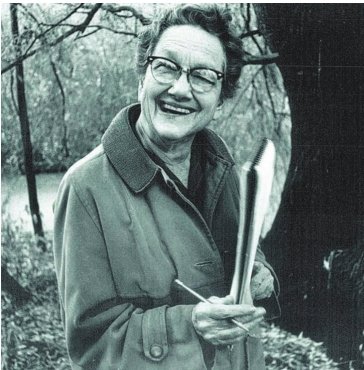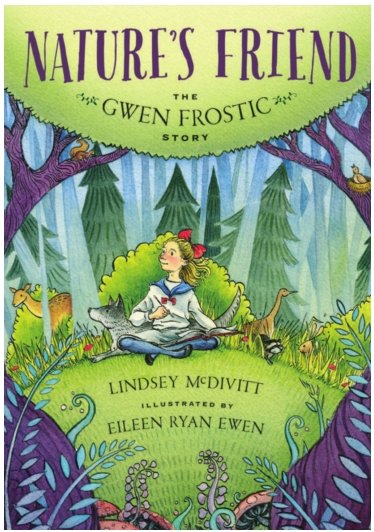
Gwen Frostic’s simple artwork representing Michigan’s natural world is easily recognizable. Drawn in by subtle colors found in nature, her forest creatures and plants are printed on everything from greeting cards to place mats. Now, she’s the subject of a new children’s picture book, “Nature’s Friend: The Gwen Frostic Story,” by Lindsey McDivitt.
It would’ve never been in Gwen Frostic’s mind that she would become one of the state’s most successful artists and business women. Born in 1906 in the small city of Sandusky, Frostic contracted a debilitating illness as a baby, which left her with a limp and week hands. Her speech was slurred, but no one could keep her from trying hard.
At the time, children with disabilities were kept at home. But her mother wouldn’t hear of it and Gwen practiced drawing to strengthen her hands. Frostic was attracted to the age old art of cutting linoleum blocks to create printing blocks, which requires great pressure to cut.
That’s where McDivitt begins the book.
McDivitt said, “Frostic’s success came through her own personal strength. She had lots of challenges, but refused to be considered as disabled.”
McDivitt follows Frostic from her childhood through adulthood, when she became one of the state’s most successful business women — selling her artwork and chapbooks worldwide from her small studio and printing operation on the Betsie River in the heart of Northern Michigan.
“She was very successful in an age when few women owned and operated a business,” McDivitt said.
Before her death in 2001, one day shy of her 95th birthday, Frostic left an estate of $13 million to Western Michigan University, which renamed its art school in her name. Her legacy lives at her studio, Presscraft Papers, which continues to produce books and stationery with her illustrations and poetry.
McDivitt said she recalls using Frostic’s greeting cards as a young environmental activist in Minnesota.
“I later moved to Michigan, and discovered who created those pieces,” she said.
Another bit of serendipity helped move the book to actuality when McDivitt’s manuscript was undergoing a “facetime” review by an editor at Sleeping Bear Press in Ann Arbor.
“Children book authors will tell you how hard it is to get noticed by publishers,” she said.
“At the end of the interview, the editor told me she had been visiting Frostic’s studio for years and she had a tattoo of Gwen’s art,” McDivitt said.
Sleeping Bear Press ultimately became the publisher of the Frostic book.
McDivitt said she was inspired by Frostic’s longevity. She worked into her nineties.
“I have a personal interest in aging well, and showing young readers that older people can still be active later in life,” McDivitt said.
Adults reading the book to young children may learn some little known facts about Frostic’s life, such as the time she spent in Detroit as a young woman building a successful art career.
A vignette in the book shows how Frostic’s hand-hammered works of copper were purchased by Detroit’s elite.
One panel shows Clare Ford, spouse of Henry Ford, placing one of Frostic’s copper vases on her shelf.
The copper pieces are quite rare. An especially interesting piece, a copper clock, is displayed in the Benzie County Historical Museums.
However, most of Frostic’s work was sold in cellophane wrapped packages from her studio on the banks of the river. When Frostic first opened her studio, it was at the end of a series of dirt roads, which are now paved.
At the studio, where Frost installed a dozen Heidelberg presses, the illustrator could step outside to find inspiration for her next work. It might be something as simple as a leaf, or a small bird perched on a limb.
McDivitt’s work will be especially appealing for young artists or naturalists. Frostic’s life needs no embellishment. Like Frostic’s work, McDivitt’s words are beautiful in their simplicity.
In one segment McDivitt describes a typical walk of Frostic:
“She walked deep into the wetlands. When Gwen sat quietly with pad and pencil, As still as a watchful fox: She seemed to hear music. She sensed magic. She witnessed small miracles.” Fans of Frostic will recognize a similar style on the hundreds of thousands greeting cards produced by Frostic from more than 2300 carved blocks of linoleum.
Frostic would nod with approval at the book’s illustrations by Eileen Ryan Ewen. She uses subtle colors drawing from Frostic’s simple, but elegant style. There are numerous small creatures tucked away in the art, which will delight young children as they find them hiding in forests.
Frostic didn’t like to be called an environmentalist, but her works of art introduced hundreds of thousands to the joys of nature. As McDivitt points out in her book, “Gwen’s art reminded everyone of nature’s beauty and importance at a time when many people had forgotten.”
Those interested in reading more about Gwen Frostic should pick up her biography, “The Life & Wisdom of Gwen Frostic,” by Sheryl James.
Support City Pulse - Donate Today!
Comments
No comments on this item Please log in to comment by clicking here